Section 6: Junction Signals and Route Indicators
(Page 3 of 5)
In June 1926, a semaphore stop signal at Blackheath (Southern Railway) with splitting distant arms underneath was renewed in directly equivalent colour light form. The new colour light signal displayed aspects identical to those previously shown by the semaphore signal at night, each semaphore arm having been substituted by a two-aspect colour light head in the same position relative to the others. When the junction signal was at 'danger', the splitting distant signal displayed a yellow light in each of its heads [6.27], even when the stop signal above was displaying a red light. When the junction signal was 'off', the appropriate head in the splitting distant signal showed a green light [6.28].
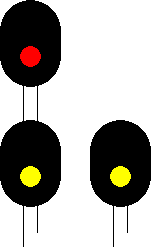 |
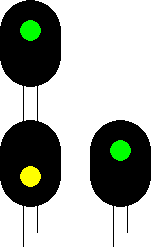 |
[6.27] Colour Light Splitting Distant Signal showing single yellow in each head (e.g. stop signal 'on').
Area: Blackheath, Southern Railway
Usage: Low
Status: Historical
|
[6.28] Colour Light Splitting Distant Signal (e.g. junction signal ahead cleared for right-hand route).
Area: Blackheath, Southern Railway
Usage: Low
Status: Historical
|
|
The Southern Railway did not usually provide route indications at shunting signals. An exception was sometimes made in the case of a signal that read either onto a running line or into a short shunt spur etc. by providing a signal for each route. When the signal for the route onto the running line was cleared it displayed the usual green light, but when the other signal was cleared for the shunt spur, a yellow light was displayed [6.29] to indicate the greater degree of caution required.
|
 |
[6.29] Directing Shunting Signal, 'off' for route towards shunt spur (e.g. right-hand route).
Area: Southern Railway
Usage: Medium
Status: Historical
|
|
Splitting distant signals in colour light form began to appear in the early 1930s on the LNER and the LMS, some being located in three or four-aspect signalling territory. Although signals of this type varied in detail between the two companies, a common feature was the provision of an additional pair of signal heads to accompany the main signal head. These additional heads remained unlit unless the main signal head and the junction signal beyond were both displaying a 'proceed' aspect (the junction signal could either be another colour light signal or a semaphore signal). If the junction signal was at 'danger', the splitting distant signal displayed just a single yellow aspect when cleared (see [2.106]).
The additional signal heads on the LNER's colour light splitting distant signals were mounted at a lower height than the main head. Both additional heads were illuminated simultaneously when the main head and the junction signal beyond were both cleared, functioning as directing distant signals. The directing distant head that was situated on the same side as the route cleared for the train at the junction ahead displayed a green light, while the other head showed a yellow light. If both routes were of a similar speed, then the two lower lights were exhibited at the same height [6.30]; otherwise, the lights were stepped according to the relative speed of each route [6.31].
On the LMS's colour light splitting distant signals, the additional signal heads were placed on either side of the main head. In contrast to the LNER signals, only one of these additional heads was illuminated when the main head and the junction signal beyond were both cleared. The illuminated additional head displayed a single yellow aspect alongside either a double yellow or green aspect in the main head [6.32]. Relative to the single yellow aspect, the other (less restrictive) aspect was positioned on the same side as the direction of the route set for the train at the junction ahead. This form of signal was used only at junctions where both routes were of comparatively equal speeds.
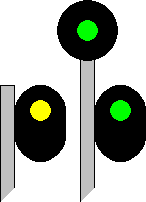 |
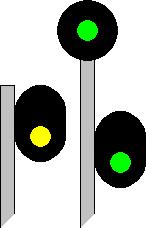 |
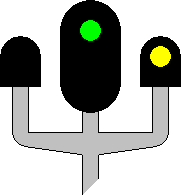 |
[6.30] Colour Light Splitting Distant Signal (e.g. junction signal ahead cleared for right-hand route; both routes of similar speed).
Area: LNER
Usage: Medium
Status: Historical
|
[6.31] Colour Light Splitting Distant Signal (e.g. junction signal ahead cleared for (lower speed) right-hand route).
Area: LNER
Usage: Medium
Status: Historical
|
[6.32] Colour Light Splitting Distant Signal (e.g. junction signal ahead cleared for left-hand route; both routes of similar speed).
Area: LMS
Usage: Medium
Status: Historical
|
During a visit to the United States in 1931, A F Bound, Signal Engineer of the LMS, became convinced of the merits of 'speed signalling', in which the driver is advised of the speed (in relative terms) at which the train may safely negotiate the route but is not explicitly informed of which route it will take. He incorporated speed signalling principles into two of the LMS's colour light signalling schemes, extensively at Mirfield in July 1932, and to a much lesser degree on the electrified lines between Camden and Watford Junction ('New' Line) in 1932/1933. In these installations, the junction signals were of the speed signalling type at junctions where the speeds of the main and diverging lines differed by more than 20 mph. When at 'danger', the junction signal displayed two red lights vertically, as well as a red marker light [6.33]. The marker light at a speed signalling junction signal was always illuminated, except when a low-speed shunting or subsidiary aspect was displayed. When a main high-speed route was set, the upper red light was replaced by an appropriate main 'proceed' aspect [6.34]. When a diverging line, medium-speed route was set, the lower red light in the main signal head (i.e. not the marker light) changed to a main 'proceed' aspect [6.35] (not including a yellow over green aspect (see [2.123]) ). The speed signalling junction signals on the Watford 'New' Line were converted to conventional route signalling junction signals in 1953.
 |
 |
 |
[6.33] Speed Signalling Junction Signal displaying a 'stop' aspect.
Area: LMS
Usage: Medium
Status: Historical
|
[6.34] Speed Signalling Junction Signal cleared for main high-speed route (e.g. 'pass second signal at restricted speed').
Area: LMS
Usage: Medium
Status: Historical
|
[6.35] Speed Signalling Junction Signal cleared for medium-speed route (e.g. 'clear').
Area: LMS
Usage: Medium
Status: Historical
|
|
The Southern Railway's earliest colour light signalling schemes included shunting signals in the form of miniature colour light signals (see [3.61 - 3.63]). The practice of providing a directing shunting signal reading either onto a running line or into a short shunt spur (see [6.29]) was perpetuated by placing two miniature colour light signals side by side. The signal applicable to the shunt spur was located on the corresponding side of the pair. When at 'danger', both signal heads showed a red aspect. When cleared for a route onto the running line, the appropriate head changed to a green 'proceed' aspect. When the other head was cleared for the shunt spur, a yellow light was displayed [6.36].
|
 |
[6.36] Directing Miniature Colour Light Shunting Signal, 'off' for route towards shunt spur (e.g. left-hand route).
Area: Southern Railway
Usage: Medium
Status: Historical
|
|
The GWR and the CLC commonly provided stencil type route indicators in association with their miniature colour light shunting signals; however, if only two route indications were required (i.e. left or right), then a special form of signal was used, which avoided the provision of a route indicator. When the signal was cleared, a green light was illuminated but the red light remained lit. The position of the green light in relation to the red light identified the direction of the route. When the left-hand route was cleared, the 'proceed' aspect was green over red [6.37]. A red over green aspect [6.38] was shown for the right-hand route. The 'off' aspects were therefore equivalent to the indications presented by a two-tier disc shunting signal during darkness.
 |
 |
[6.37] Miniature Colour Light Shunting Signal, 'off' for left-hand route.
Area: GWR / CLC
Usage: Medium
Status: Historical
|
[6.38] Miniature Colour Light Shunting Signal, 'off' for right-hand route.
Area: GWR / CLC
Usage: Medium
Status: Historical
|
|
The GWR's resignalling at Cardiff in 1933/1934 featured an unusual form of route indicator, which was provided on shunting signals that were elevated. These were known as 'pointer light' route indicators, and they closely resembled those designed by W K Wallace, which were put into service at the LMS Northern Counties Committee's terminus at York Road, Belfast, in 1926. The pointer light route indicators provided at Cardiff comprised pairs of small red and green lights, one pair for every possible route from the signal (up to a maximum of ten). These lights were all extinguished when the associated shunting signal displayed a 'stop' aspect. When the signal was cleared, all the red lights in the route indicator were illuminated, except for the one that corresponded in position to the route that was set. The green light in that position was illuminated instead [6.39].
|
 |
[6.39] Pointer Light Route Indicator (e.g. second route from the left is set, out of a possible eight routes).
Area: Cardiff, GWR
Usage: Medium
Status: Historical
|
|
|
In some areas, forward-facing route indicators displayed the various indications in an amber or yellow colour [6.40] to prevent glare. Where rear-facing route indicators were provided, these displayed their indications in white. The practice was reversed in 1960, amber-coloured indications thereafter being reserved for rear-facing indicators.
|
 |
[6.40] Route Indicator displaying Amber Indication (e.g. theatre type).
Area: Various
Usage: High
Status: Historical
|
|
In 1933, the LNER undertook a trial of a new form of route indicator for use in conjunction with a colour light junction signal, as an alternative to providing separate signal heads (see [6.23 & 6.24]). The signal selected for this trial was U22C at Thirsk, a three-aspect searchlight signal with additional offset heads for the diverging routes to the left and right of the Up Main line. Invented by A E Tattersall and patented by him, the new indicator displayed a bar of light formed of neon tubes, fixed at an appropriate angle to indicate the direction of the route. When the signal was at 'danger', no route indication was shown. When the straight-ahead route was set, a vertical bar of deep orange light was illuminated [6.41]. When a diverging route was set, the bar of light was inclined at 45° to the left or right, as appropriate [6.42]. Although the principle of the junction indicator was met with approval, the deep orange hue of the neon tubes and the high voltage needed to illuminate them resulted in no more of this style being installed.
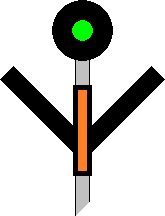 |
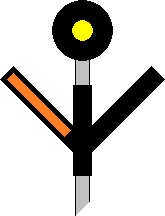 |
[6.41] Experimental Junction Indicator (e.g. straight route set; signal at 'clear').
Area: Thirsk, LNER
Usage: Low
Status: Historical
|
[6.42] Experimental Junction Indicator (e.g. left-hand diverging route set; signal at 'caution').
Area: Thirsk, LNER
Usage: Low
Status: Historical
|











